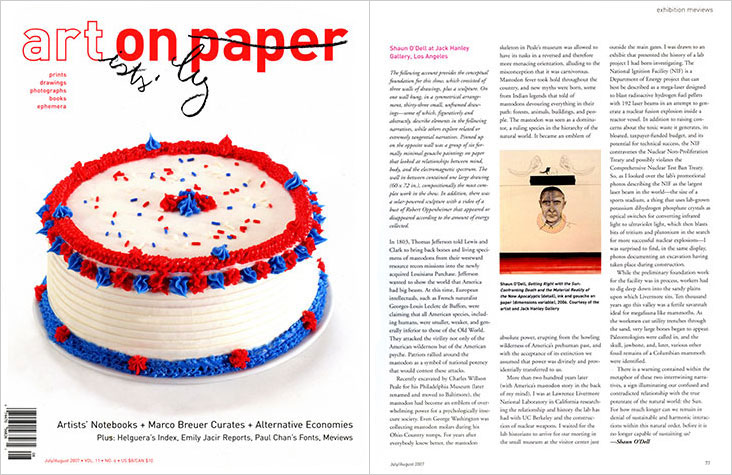
In 1803 Thomas Jefferson told Lewis and Clark to bring back bones and living specimens of mastodons from their westward resource recon missions into the newly acquired Louisiana Purchase. Jefferson wanted to show the world that America had big beasts. At this time European intellectuals like French naturalist George-Louis Leclerc de Buffon were claiming that all American species, including humans, were smaller, weaker and generally inferior to those of the Old World. They attacked the virility not only of the American wilderness but of the American psyche. Patriots rallied around the mastodon as a symbol of national potency that would contest these attacks.
Recently excavated by Charles Wilson Peale for his Philadelphia Museum, the mastodon had become an emblem of overwhelming power for a psychologically insecure society. Even George Washington was collecting mastodon molars during his Ohio country romps. For years after everybody knew better, the mastodon skeleton in Peale’s museum was allowed to have its tusks in a reversed and therefore more menacing orientation, alluding to the misconception that it was carnivorous. Mastodon-fever took hold throughout the country and new myths were borne - some from Indian legends that told of mastodons devouring everything in their path: forests, animals, buildings and people. The mastodon was seen as a dominator, a ruling species in the hierarchy of the natural world, and it became an emblem of absolute power erupting from the howling wilderness of America’s pre-human past and with the acceptance of its extinction we assumed that power was divinely and providentially transferred to us.
More than 200 years later (with America’s mastodon story in the back of my mind) I was at Lawrence Livermore National Laboratory researching the relationship and history the lab has had with UC Berkeley and the construction of nuclear weapons. I waited for the lab historians to arrive for our meeting in the small museum at the visitor center just outside the main gates. I was drawn to an exhibit that presented the history of a lab project I had been investigating. The National Ignition Facility is a Department of Energy project described as a mega-laser designed to blast radioactive hydrogen fuel pellets with 192 laser beams to create a nuclear fusion explosion inside a reactor vessel. Aside from the toxic waste issues, the over-budget taxpayer-funded costs, and doubts about technical success, the NIF contravenes the nuclear Non-Proliferation Treaty and possibly violates the Comprehensive Test Ban Treaty. So, as I looked over the lab’s promotional photos describing the NIF as the largest laser beam in the world – the size of a sports stadium, and a thing that uses lab grown Potassium Dihydrogen Phosphate crystals as optical switches for converting infrared light to ultraviolet light which then bombard bits of tritium and plutonium in the search for more successful nuclear explosions – I was surprised to find additional photos documenting an excavation having taken place during construction.
While the preliminary foundation work for the facility was in process, workers had to dig deep down into the sandy plains upon which Livermore sits. Ten thousand years ago this valley was a fertile savannah ideal for megafauna like mammoths. As the workmen cut utility trenches through the sand, very large bones began to appear. Paleontologists were called in and the skull, jawbone and later, various other fossil remains of a Columbian mammoth were identified.
There is a warning contained within the metaphor of these two intertwining narratives, a sign that reveals our hubristic efforts at dominating nature as a projection of power and further – like some apocalyptic omen – illuminates our contradicted relationship with the true potentate of the natural world: the Sun. For how much longer can we remain in denial of sustainable and harmonic interactions within the natural order, before it is no longer capable of sustaining us?
The previous account was the conceptual foundation for a show that consisted of 33 small, unframed drawings symmetrically organized on one wall and another group of six drawings on the opposing wall and one large drawing (60’x72’) on the middle wall. In addition there was a solar powered sculpture/video of an Oppenheimer bust that appeared or disappeared according to the amount of energy collected. Some of the drawings in the large group figuratively and abstractly describe elements from the above narratives. Others explored related or more tangential narratives. The six drawings on the opposite wall looked at relationships between mind, body and the electromagnetic spectrum. They were formally minimal and pinned up in sequential order, also done in gouache on paper. The piece on the middle wall was compositionally the most complex, combining elements of all the other 39 drawings.